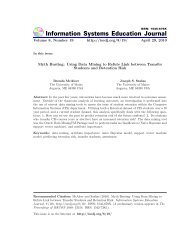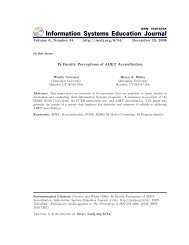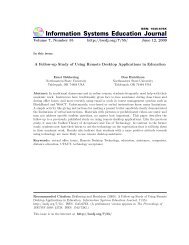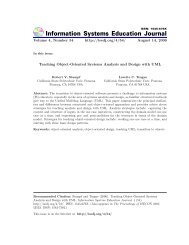Slickr: A Multi-Tiered Web Development Capstone Project Using ...
Slickr: A Multi-Tiered Web Development Capstone Project Using ...
Slickr: A Multi-Tiered Web Development Capstone Project Using ...
You also want an ePaper? Increase the reach of your titles
YUMPU automatically turns print PDFs into web optimized ePapers that Google loves.
ISEDJ 6 (37) Frydenberg 8<br />
Students can create sophisticated user interfaces<br />
with very little coding by using the<br />
toolkit controls.<br />
5. <strong>Slickr</strong>: A CAPSTONE PROJECT USING<br />
A SQLServer DATABASE,<br />
WEB SERVICES, AND ASP.NET AJAX<br />
Phase 1: <strong>Slickr</strong><br />
Overview. CS 380 students use Microsoft<br />
Visual Studio with ASP.NET in C# to create<br />
data-driven distributed web applications.<br />
For their database assignment, students<br />
created a simple photo-sharing web application<br />
dubbed “<strong>Slickr</strong>”, a simple imitation of<br />
the popular Flickr photo-sharing web site.<br />
The assignment had students create a <strong>Slickr</strong><br />
web site on which users may perform the<br />
following tasks:<br />
• Create albums and upload photos into<br />
specific albums<br />
• Associate a description and one or more<br />
user-specified tags with a photo<br />
• Search albums for photos with specific<br />
tags, and display matching photos<br />
• Ability to edit and delete album or tag<br />
names, and photo descriptions<br />
To fulfill the technical requirements for this<br />
assignment, students also had to create C#<br />
classes to model all relevant objects, define<br />
and invoke at least one stored procedure,<br />
and implement a data access layer class. In<br />
addition, their application pages had to<br />
make use of both SqlDataSource and ObjectDataSource<br />
controls a least once.<br />
To encourage individual creativity, students<br />
also had to identify an additional feature to<br />
implement in their <strong>Slickr</strong> application. Some<br />
students made these enhancements:<br />
• Designating a picture as the “album image”<br />
to be displayed along with the album<br />
name.<br />
• Rating pictures numerically and displaying<br />
an average rating for each.<br />
• Implementing “tag clouds” to display<br />
more frequently used tags in larger<br />
fonts, and less frequently used tags in<br />
smaller fonts.<br />
In a later lesson on ASP.NET security controls,<br />
students enhanced the project to create<br />
two users with different privileges. An<br />
administrative user had privileges to search<br />
and view pictures, upload pictures, and edit<br />
titles, tags and descriptions. A standard user<br />
could only search and view pictures.<br />
Some students added the ability for users to<br />
“log in” and access their own set of albums,<br />
to be able to perform the functionality<br />
above. This required adding a User table,<br />
and a composite primary key to the Album<br />
table, so that one user might have many<br />
albums.<br />
Object Model: While it may be natural to<br />
begin by designing the database tables,<br />
modeling the objects independent of any<br />
database implementation helps to better<br />
consider the attributes and methods associated<br />
with the objects themselves, and those<br />
associated with their data access. This<br />
model, shown in Figure 3, separates the information<br />
inherent to a particular object<br />
from the additional information (primary<br />
keys) that will be required to store it in a<br />
database.<br />
Figure 3 (a). <strong>Slickr</strong> Object Model<br />
c○ 2008 EDSIG http://isedj.org/6/37/ March 18, 2008







